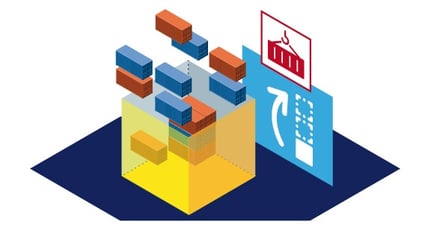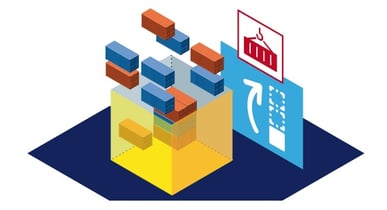A Fruitful Union: The Intersection of Industry 4.0 and Logistics 4.0
Brian Hoey - May 22, 2018

 Industry 4.0, also known as the Fourth Industrial Revolution, has been hailed as the underpinning of the modern smart factory, promoting the rise of cyber-physical systems, increased machine-to-machine communication, and decentralized decision-making within production processes. The concepts that make up the Industry 4.0 framework have been suitably revolutionary, and they're rapidly changing the way that manufacturing businesses operate, but many organizations are realizing that this framework doesn’t have to stop at the edge of the factory floor. Indeed, the very same principles that drive modern, digitized manufacturing are also bringing about the era of Logistics 4.0.
Industry 4.0, also known as the Fourth Industrial Revolution, has been hailed as the underpinning of the modern smart factory, promoting the rise of cyber-physical systems, increased machine-to-machine communication, and decentralized decision-making within production processes. The concepts that make up the Industry 4.0 framework have been suitably revolutionary, and they're rapidly changing the way that manufacturing businesses operate, but many organizations are realizing that this framework doesn’t have to stop at the edge of the factory floor. Indeed, the very same principles that drive modern, digitized manufacturing are also bringing about the era of Logistics 4.0.
What is Logistics 4.0?
Now, you may be wondering, what exactly is Logistics 4.0? Simply put, it is the extension of cyber-physical systems and machine-to-machine communication beyond the bounds of industrial manufacturing, into the supply chain as a whole and logistics in particular. Just as the smart factory makes possible a host of organizational improvements based on new, connected technology, smart logistics relies on things like RFID chips and Internet of Things (IoT) devices in vehicles and warehouses in order to boost connectivity and visibility throughout transport operations.
To speak a little more broadly, this new paradigm in logistics represents the natural outgrowth of the digitization trend that has been driving the evolution of the supply chain in recent years, taking transport plans from siloized, pen-and-paper affairs to highly visible, agile, and adaptable workflows. The natural result of logistics processes becoming digitized has been and will continue to be the addition of value through smarter and more efficient processes, increased collaboration, and fewer bottlenecks as a result of improved data visibility.
Digitization/Integration
While Logistics 4.0 utilizes the same principles of interconnectivity and interoperability that define Industry 4.0, you might be inclined to ask, “how do these two new paradigms interact with one another within the context of the global value chain?” The simple answer is that they bring logistics and manufacturing into closer and more agile contact than ever, leading to an environment in which inter-organizational communication and visibility promote collaboration and added value.
We’ve discussed in the past the potential for increased end-to-end (E2E) visibility within a manufacturing organization to increase visibility upstream to suppliers and downstream to eventual customers, and this is equally true when it comes to shippers, freight forwarders, and others in the logistics industry. In cases where shippers are equipping their fleets with IoT connected devices, for instance, shipments can be tracked both internally by freight forwarders and by planners within manufacturing organizations that might be waiting for a shipment of parts, who can then adjust production plans as necessary based on when they project that the parts will arrive. By the same token, shippers can share real-time pricing information with potential clients in order to build stronger and more open partnerships.
A Match Made in Heaven
Just as digitized logistics processes can integrate in a value-additive manner with digitized manufacturers and other businesses, Industry 4.0 offers a host of potential benefits that can only be taken advantage of in smart, digitized workflows. As inventory warehouses become increasingly IoT-enabled, for instance, any given product that might eventually require shipping can be tracked through its entire lifecycle, meaning that freight forwarders that are sufficiently advanced in their IT can make decisions based on knowledge of exactly where each product is even before it’s ready to be shipped. With this new knowledge, planners can make more informed decisions about routing and truck capacity utilization, potentially developing more efficient, and therefore more cost effective plans for getting the right products to the right places at the right times.
We’ve seen in the paragraphs above the extent to which Industry 4.0 and Logistics 4.0 can interact in a synergistic, mutually value-additive manner, but perhaps the most striking thing about these two new paradigms is not the minutiae of how each one can inform the processes and workflows of the other, but what they signal about the future of supply chain management as a whole. As industry becomes more advanced, cyber-physical systems will enable more autonomous machine decision-making, not just on production floors but in warehouses, and, with the eventual rise of driverless cars, along shipping routes.
By the same token, we are already entering an era in which heat, weight, and light sensors can detect the conditions of freight as it’s being transported and products as they’re being assembled on the factory floor, providing alerts for transport and production planners in real-time so that breakdowns and bottlenecks related to damaged parts can be more consistently avoided. Improvements like this one stand to have a snowball effect on the global supply chain, making complex, interconnected processes run more smoothly, with fewer breakdowns and shorter lead times.
LATEST POSTS
- Understand Why Production Planning Needs Specialized Solutions
- Understand Circular Economy in The Manufacturing Industry
- How Can Industry 4.0 IT Integration Be Achieved Smoothly?
- The Significance of Order Sequencing in Discrete Manufacturing
- How to improve your Supply Chain Management: The Power of Control Towers



